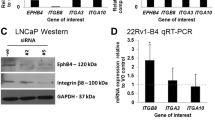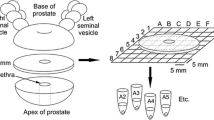Abstract
We compared the levels of mRNA transcripts encoding E-cadherin, N-cadherin,Β 1 integrin subunit,α 5 integrin subunit and fibronectin in the normal rat prostate gland, as well as in tumors derived from three invasive sublines (G, MatLyLu, AT-2) of the Dunning R-3227 rat prostatic adenocarcinoma. E-cadherin mRNA transcripts were only detectable in total RNA extracts prepared from normal rat prostates, whereas N-cadherin mRNA transcripts were only found in normal rat brains. In contrast, the mRNA transcripts encoding theΒ 1 integrin subunit,α 5 integrin subunit and fibronectin were all elevated in the tumors, as compared to the levels of these transcripts in normal tissues. Our results suggest that there is an inverse correlation between cadherin and integrin mRNA levels in rat prostatic tumors.
Similar content being viewed by others
References
Edelman GM. Morphoregulation.Dev Dynamics 1992,193, 2–10.
Takeichi M. Cadherin cell adhesion receptors as a morphogenetic regulator.Science 1991,251, 1451–5.
Hynes RO. Integrins: versatility, modulation, and signalling in cell adhesion.Cell 1992,69, 11–25.
Blaschuk OW, Sullivan R, David S and Pouliot Y. Identification of a cadherin cell adhesion recognition sequence.Dev Biol 1990,139, 227–9.
Pouliot Y, Holland PC and Blaschuk OW. Developmental regulation of a cadherin during the differentiation of skeletal myoblasts.Dev Biol 1990,141, 292–8.
Knudsen K. Cell adhesion molecules in myogenesis.Curr Op Cell Biol 1990,2, 902–6.
Neugebauer KM, Tomaselli KJ, Lilien J and Reichardt LF. N-cadherin, N-CAM, and integrins promote retinal neurite outgrowth on astrocytesin vitro.J Cell Biol 1988,107, 1177–87.
Albelda SM and Buck CA. Integrins and other cell adhesion molecules. FASEB J 1990,4, 2868–80.
Massague J. The transforming growth factor-Β family.Ann Rev Cell Biol 1990,6, 597–641.
Nose A and Takeichi M. A novel cadherin adhesion molecule: its expression patterns associated with implantation and organogenesis of mouse embryos.J Cell Biol 1986,103, 2649–58.
Shimoyama Y, Hirohashi S, Hiraho Set al. Cadherin cell adhesion molecules in human epithelial tissues and carcinomas.Cancer Res 1989,49, 2128–33.
Gumbiner B. Generation and maintenance of epithelial cell polarity.Curr Op Cell Biol 1990,2, 881–7.
Citi S. The molecular organization of tight junctions.J Cell Biol 1993,121, 485–9.
Birchmeier W, Behrens J, Weidner KMet al. Dominant and recessive genes involved in tumor cell invasion.Curr Op Cell Biol 1992,3, 832–40.
Hedrick L. Cho KR and Vogelstein B. Cell adhesion molecules as tumor suppressors.Trends Cell Biol 1993,3, 36–9.
Behrens J, Mareel MM, Van Roy FMet al. Dissecting tumor cell invasion: epithelial cells acquire invasive properties after the loss of uvomorulin-mediated cell-cell adhesion.J Cell Biol 1989,108, 2435–47.
Vleminckx K, Vakaet Jr. L, Mareel Met al. Genetic manipulation of E-cadherin expression by epithelial tumor cells reveals an invasion suppressor role.Cell 1991,66, 107–19.
Bussemakers MJG, Moorselaar RJA van, Giroldi LAet al. Decreased expression of E-cadherin in the progression of rat prostatic cancer.Cancer Res 1992,52, 2916–22.
Schwartz MA. Signalling by integrins: implications for tumorigenesis.Cancer Res 1993,53, 1503–6.
Ruoslahti E and Giancotti FG. Integrins and tumor cell dissemination.Cancer Cells 1989,1, 119–26.
Dedhar S. Integrins and tumor invasion.BioEssays 1990,12, 583–90.
Isaacs JT, Isaacs WB, Feitz WFJet al. Establishment and characterization of seven Dunning rat prostatic cancer cell lines and their use in developing methods for predicting metastatic abilities of prostatic cancers.Prostate 1986,9, 261–81.
Chomczynski P and Sacchi N. Single-step method of RNA isolation by acid guanidinium thiocyantephenol-chloroform extraction.Analyt Biochem 1987,162, 156–9.
Davis LG, Dibner MD and Battey JF, eds.Basic Methods in Molecular Biology. New York: Elsevier Science Publishing Co., 1986.
Chen B, Blaschuk OW and Hales BF. Cadherin mRNAs during rat embryo developmentin vivo andin vitro.Teratology 1991,44, 581–90.
Feinberg AP and Vogelstein B. A technique for radiolabeling DNA restriction endonuclease fragments to high specific activity.Analyt Biochem 1983,132, 6–13.
Albelda SM. Role of integrins and other cell adhesion molecules in tumor progression and metastasis.Lab Invest 1993,68, 4–17.
Dedhar S and Saulnier R. Alterations in integrin receptor expression on chemically transformed human cells: specific enhancement of laminin and collagen receptor complexes.J Cell Biol 1990,110, 481–9.
Mortarini R, Gismondi A, Santoni Aet al. Role of theα5Β1 integrin receptor in the proliferative response of quiescent human melanoma cells to fibronectin.Cancer Res 1992,52, 4499–506.
Demeure MJ, Damsky CH, Elfman Fet al. Invasion by cultured human follicular thyroid cancer correlates with increasedΒ1 integrins and production of proteases.World J Surg 1992,16, 770–6.
Bonkhoff H, Stein U and Remberger K. Differential expression ofα6 andα2 very late antigen integrins in the normal, hyperplastic, and neoplastic prostate: simultaneous demonstration of cell surface receptors and their extracellular ligands.Human Pathol 1993,24, 243–8.
Giancotti FG and Ruoslahti E. Elevated levels of theα5Β1 fibronectin receptor suppress the transformed phenotype of Chinese hamster ovary cells.Cell 1990,60, 849–59.
Author information
Authors and Affiliations
Rights and permissions
About this article
Cite this article
MacCalman, C.D., Brodt, P., Doublet, J.D. et al. The loss of E-cadherin mRNA transcripts in rat prostatic tumors is accompanied by increased expression of mRNA transcripts encoding fibronectin and its receptor. Clin Exp Metast 12, 101–107 (1994). https://doi.org/10.1007/BF01753976
Received:
Accepted:
Issue Date:
DOI: https://doi.org/10.1007/BF01753976




